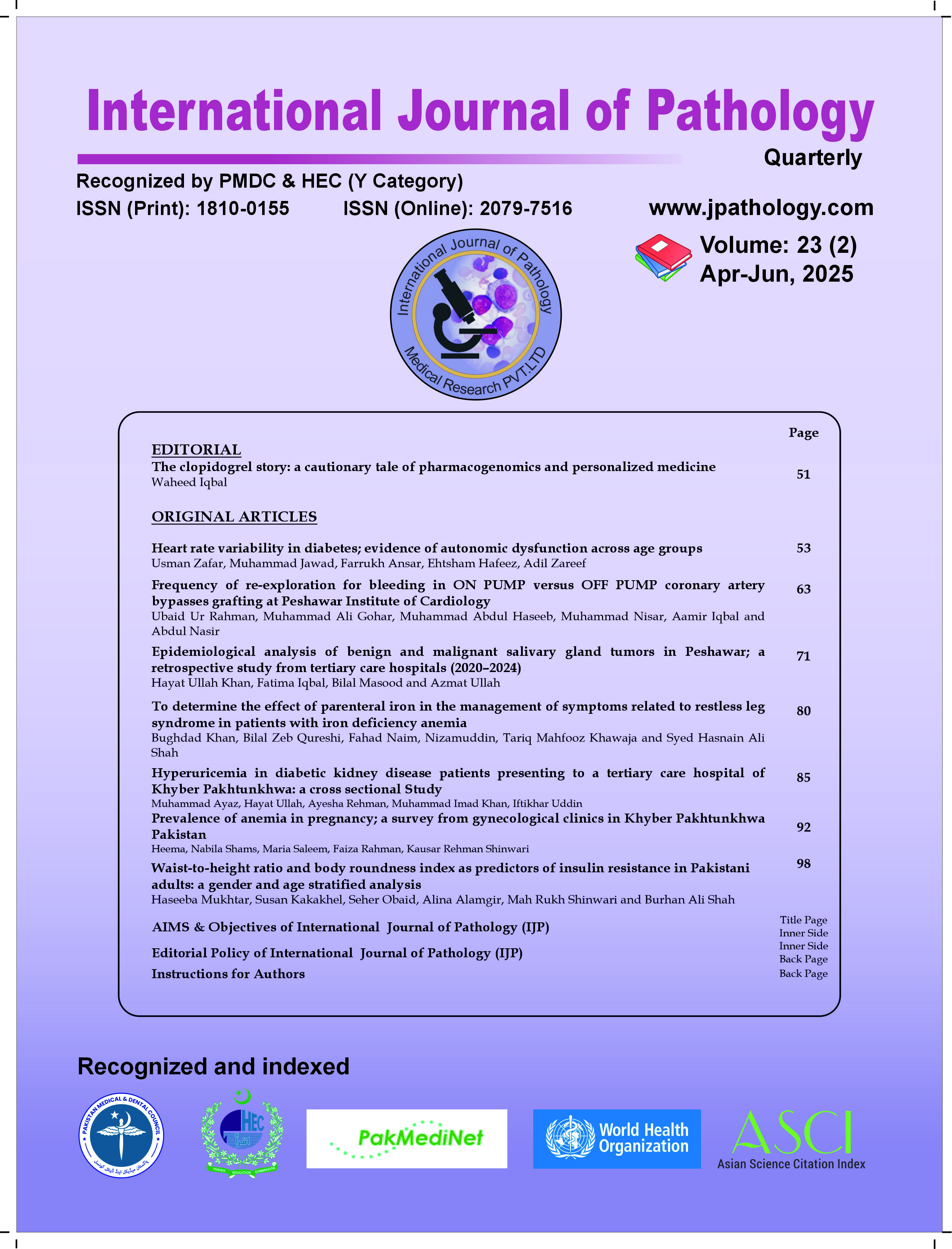Epidemiological analysis of benign and malignant salivary gland tumors in Peshawar
a retrospective study from tertiary care hospitals (2020–2024)
DOI:
https://doi.org/10.59736/IJP.23.02.950Keywords:
Salivary gland tumor, Epidemiology , Parotid gland tumors, Malignant tumor, Benign tumorAbstract
Background: Salivary gland tumors are rare lesions that pose diagnostic and therapeutic challenges due to their histological diversity and variable behavior. This study aimed to characterize the demographic and clinicopathological features of primary salivary gland tumors treated at two tertiary centers in Peshawar, and to assess associations between tumor behavior and patient age, sex, and tumor site.
Methods: We conducted a retrospective review of 272 patients treated for primary salivary gland tumors at two tertiary centers in Peshawar between January 2020 and December 2024. Patient demographics, tumor site, histological subtype, and behavior were extracted from pathology reports and clinical records. Statistical associations between tumor type and age, sex, and anatomical location were assessed with p < 0.05 indicating significance.
Results: The cohort included 147 women (54.0%) and 125 men (46.0%), with a mean age of 45 years (range 0–100 years). Benign tumors comprised 74.6% (n = 203), most frequently arising in the parotid gland (76.5%), whereas malignant tumors accounted for 25.4% (n = 69) and were disproportionately found in minor salivary glands (33.3% malignant). Pleomorphic adenoma was the leading benign subtype (70.4%), and mucoepidermoid carcinoma was the predominant malignancy (26.1%). Malignancy rates increased with age, rising from 7.7% in patients under 20 to 100% in those over 80 (p = 0.006). No significant gender differences in tumor behavior were observed (p = 0.48), but the distribution of sexes varied across age groups.
Conclusion: Younger patients with small, asymptomatic lesions may be managed conservatively, while older patients and those with minor gland tumors warrant prompt biopsy and cytological evaluation. Prospective, multicenter registries are essential to refine these observations and guide resource allocation in similar settings.
References
Alsanie I, Rajab S, Cottom H, Adegun O, Agarwal R, Jay A, et al. Distribution and frequency of salivary gland tumours: an international multicenter study. Head Neck Pathol. 2022; 16(4):1043–54.
Steuer CE, Hanna GJ, Viswanathan K, Bates JE, Kaka AS, Schmitt NC, et al. The evolving landscape of salivary gland tumors. CA Cancer J Clin. 2023; 73(6):597–619.
Morgan E, Arnold M, Gini A, Lorenzoni V, Cabasag C, Laversanne M, et al. Global burden of colorectal cancer in 2020 and 2040: incidence and mortality estimates from GLOBOCAN. Gut. 2023; 72(2):338–44.
Van Herpen C, Vander Poorten V, Skalova A, Terhaard C, Maroldi R, van Engen A, et al. Salivary gland cancer: ESMO–European Reference Network on Rare Adult Solid Cancers (EURACAN) clinical practice guideline for diagnosis, treatment and follow-up. ESMO Open. 2022; 7(6):100602.
Olteanu GE, Brcic L. Pulmonary puzzles: salivary gland-type tumors of the lung and their metastatic equivalents. Memo. 2024; 17(2):110–6.
AlMaden N, AlYami R, Almotairi A, Alrasheed R, Aldawasri B, Alwhabi M, et al. Relative frequency of primary salivary gland tumors: multicenter study of 796 cases from Riyadh, Saudi Arabia. Medicina (Kaunas). 2024; 60(12):2022.
Locati LD, Ferrarotto R, Licitra L, Benazzo M, Preda L, Farina D, et al. Current management and future challenges in salivary glands cancer. Front Oncol. 2023; 13:1264287.
Nosé V, Lazar AJ. Update from the 5th edition of the World Health Organization classification of head and neck tumors: familial tumor syndromes. Head Neck Pathol. 2022; 16(1):143–57.
Malik M, Noushin T, Hanif M, Khan IA, Ali I, Khan HU. Salivary gland tumors: 10 years’ experience at Peshawar Medical College. Int J Pathol. 2023; 21(2):75–80.
Mahmood HN, Haseeb AA, Riaz N, Firdous S, Hanif S, Khan SR. A clinicopathological analysis of 75 salivary gland tumors at Mayo Hospital, Lahore. Pak J Med Health Sci. 2022; 16(2):223–6.
Ashfaq S, Alam S, Khan MM, Nasir S. Mucin-2 expression in primary and recurrent cases of pleomorphic adenoma in tertiary care hospitals of Peshawar. Pak J Med Dent. 2024; 13(2):9–15.
Young A, Okuyemi OT. Malignant salivary gland tumors. In: StatPearls [Internet]. Treasure Island (FL): StatPearls Publishing; 2020. Available from: https://www.ncbi.nlm.nih.gov/books/NBK537081/
Ghaderi H, Kruger E, Ahmadvand S, Mohammadi Y, Khademi B, Ghaderi A. Epidemiological profile of salivary gland tumors in Southern Iranian population: a retrospective study of 405 cases. J Cancer Epidemiol. 2023; 2023:8844535.
Wang X, Bai J, Yan J, Li B. The clinical outcome, pathologic spectrum, and genomic landscape for 454 cases of salivary mucoepidermoid carcinoma. NPJ Precis Oncol. 2024; 8(1):238.
Matsumiya-Matsumoto Y, Morita Y, Uzawa N. Pleomorphic adenoma of the salivary glands and epithelial–mesenchymal transition. J Clin Med. 2022; 11(14):4210.
Boahene DKO, Olsen KD, Lewis JE, Pinheiro AD, Pankratz VS, Bagniewski SM. Mucoepidermoid carcinoma of the parotid gland: the Mayo Clinic experience. Arch Otolaryngol Head Neck Surg. 2004; 130(7):849–56.
Chalmers K, Staibano P, Gupta MK, Au M. Mucoepidermoid carcinoma of unknown primary in the head and neck: a case report and review of the literature. J Laryngol Otol. 2024; 138(1):1–16.
Do Quyen HT, Duc NM, Tuan HX, Tu NHT, Khoi NA, Dung PX. Acinic cell carcinoma of parotid gland. Radiol Case Rep. 2023; 18(6):2194–8.
de Oliveira FA, Duarte ECB, Taveira CT, Máximo AA, de Aquino EC, Alencar RC, et al. Salivary gland tumor: a review of 599 cases in a Brazilian population. Head Neck Pathol. 2009; 3(4):271–5.
Punita L, Naik N, Prasad P, Kesari A, Shankar R, Kumar A, et al. Salivary gland tumors: an audit from a tertiary care centre in Northern India. Indian J Otolaryngol Head Neck Surg. 2024; 76(3):2660–74.
Taha WSAEA, Wali ME, Amer HW. Prevalence of salivary gland neoplasms in the head and neck in educational hospitals in Cairo Governorate. Int J Health Sci (Qassim). 2023; 6(S9):1840–52.
Araya J, Martinez R, Niklander S, Marshall M, Esguep A. Incidence and prevalence of salivary gland tumours in Valparaiso, Chile. Med Oral Patol Oral Cir Bucal. 2015; 20(5):e532–6.
Kordzińska-Cisek I, Grzybowska-Szatkowska L. Salivary gland cancer—epidemiology. Nowotwory J Oncol. 2018; 68(1):22–7.
Alsharif MN, Alhomsi K. Salivary glands tumors: demographics and occurrence according to age and gender. Eur J Biomed. 2020; 7(6):508–14.
Assar S, Assar S, Mardanifard HA, Jaafari-Ashkavandi Z. Salivary gland tumors in Iran: a systematic review of 2870 cases based on the new WHO classification. Iran J Pathol. 2023; 18(1):1–9.
de Lima WP, Gordón-Núñez MA, Alves PM. Salivary gland tumors: a 13-year clinicopathologic retrospective study in a Brazilian northeast population. J Clin Exp Dent. 2023; 15(2):e88–94.
Grobbelaar J, Wright KE, Thomas A, Adam SE. Minor salivary gland tumours: malignant or benign? A 10-year local retrospective review. J Coll Med South Afr. 2025; 3(1):126–31.
Hacioglu MB, Erdogan B, Bardakcı M, Algın E, Gulbagcı B, Hacibekiroglu I, et al. Major and minor salivary gland cancers: a multicenter retrospective study. Head Neck. 2023; 45(7):1643–53.
Vuhahula EA, Yahaya JJ, Ngaiza AI, Morgan ED, Abraham ZS. Predictors of recurrence and disease-free survival for salivary gland tumors among children and young adults in Kampala, Uganda: a retrospective follow-up study. Egypt J Otolaryngol. 2023; 39(1):33.
Valletti PA, Campagnoli M, Dell'Era V, Garzaro M, Boffano P, Neirotti F, et al. Oral and oropharyngeal malignant minor salivary gland tumors: a retrospective study. J Stomatol Oral Maxillofac Surg. 2024; 125(4):101893.
Sansar B, Singh N, Gupta A, Mishra BK, Sharma A, Rai R, et al. Incurable advanced salivary gland tumours: a retrospective analysis and peek into the perplexing clinical and molecular intricacies from a tertiary care centre in India. Ecancermedicalscience. 2023; 17:1602.
AlSalem A, AlKraidees M, AlKarni A, Yahya B, AlRamyan R, AlSumairi S, et al. Major salivary gland carcinoma in KSA: a 10-year nationwide retrospective study of 571 cases. J Taibah Univ Med Sci. 2023; 18(5):1148–56.
Downloads
Published
Issue
Section
License
Copyright (c) 2025 Hayat Ullah Khan, Fatima Iqbal, Bilal Masood, Azmat Ullah

This work is licensed under a Creative Commons Attribution-NonCommercial 4.0 International License.
Readers may “Share-copy and redistribute the material in any medium or format” and “Adapt-remix, transform, and build upon the material”. The readers must give appropriate credit to the source of the material and indicate if changes were made to the material. Readers may not use the material for commercial purpose. The readers may not apply legal terms or technological measures that legally restrict others from doing anything the license permits.


